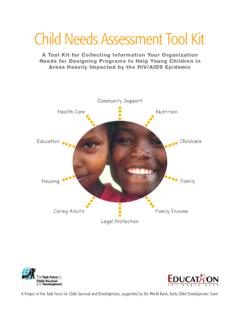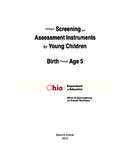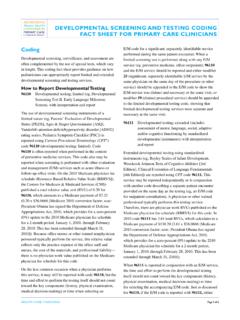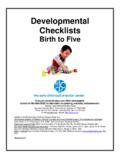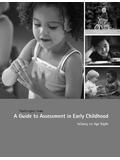Transcription of OECD/OCDE 414
1 OECD/OCDE414 Adopted:22ndJanuary 20011/11 OECD GUIDELINE FOR THE TESTING OF CHEMICALSPROPOSAL FOR UPDATING GUIDELINE 414 Prenatal developmental Toxicity Copenhagen in June 1995, an OECD Working Group on Reproduction and DevelopmentalToxicity discussed the need to update existing OECD Test Guidelines for reproduction and developmentaltoxicity and the development of new Guidelines for endpoints not yet Working Grouprecommended that the Guideline for developmental Toxicity should be revised, based on a proposal receivedfrom the US (1). The Working Group reached agreement on all major elements of the revised version of guideline for developmental toxicity testing is designed to provide general informationconcerning the effects of prenatal exposure on the pregnant test animal and on the developing organism; thismay include assessment of maternal effects as well as death, structural abnormalities, or altered growth in thefoetus.
2 Functional deficits, although an important part of development, are not a part of this Guideline. Theymay be tested for in a separate study or as an adjunct to this study using the Guideline for developmentalneurotoxicity. For information on testing for functional deficiencies and other postnatal effects the Guidelinesfor the two-generation reproductive toxicity study and the developmental neurotoxicity study should guideline may require specific adaptation in individual cases on the basis of specific knowledgeon physicochemical or toxicological properties of the test substance. Such adaptation is acceptable, whenconvincing scientific evidence suggests that the adaptation will lead to a more informative test.
3 In such a case,this scientific evidence should be carefully documented in the study used are given in the OF THE , the test substance is administered to pregnant animals at least from implantation to one dayprior to the day of scheduled kill, which should be as close as possible to the normal day of delivery withoutrisking loss of data resulting from early delivery. The guideline is not intended to examine solely the period oforganogenesis, ( days 5-15 in the rodent, and days 6-18 in the rabbit) but also effects from preimplantation,when appropriate, through the entire period of gestation to the day before caesarean section. Shortly before414 OECD/OCDE2/13caesarean section, the females are killed, the uterine contents are examined, and the foetuses are evaluated forsoft tissue and skeletal FOR THE TESTS election of animal is recommended that testing be performed in the most relevant species, and that laboratory speciesand strains which are commonly used in prenatal developmental toxicity testing be employed.
4 The preferredrodent species is the rat and the preferred non-rodent species is the rabbit. Justification should be provided ifanother species is and feeding temperature in the experimental animal room should be 22 ( 3 C) for rodents and 18 ( 3 C)rabbits. Although the relative humidity should be at least 30% and preferably not exceed 70% other thanduring room cleaning, the aim should be 50-60%. Lighting should be artificial, the sequence being 12 hourslight, 12 hours dark. For feeding, conventional laboratory diets may be used with an unlimited supply ofdrinking procedures should be carried out in cages suitable for the purpose.
5 While individual housing ofmated animals is preferred, group housing in small numbers is also of the animals, which have been acclimated to laboratory conditions for at least 5 days and havenot been subjected to previous experimental procedures, should be test animals should becharacterised as to species, strain, source, sex, weight and/or age. The animals of all test groups should, asnearly as practicable, be of uniform weight and adult nulliparous female animals should be used ateach dose level. The females should be mated with males of the same species and strain, and the mating ofsiblings should be avoided. For rodents day 0 of gestation is the day on which a vaginal plug and/or sperm areobserved; for rabbits day 0 is usually the day of coitus or of artificial insemination, if this technique is females should be assigned in an unbiased manner to the control and treatment groups.
6 Cages shouldbe arranged in such a way that possible effects due to cage placement are minimised. Each animal should beassigned a unique identification number. Mated females should be assigned in an unbiased manner to thecontrol and treatment groups, and if the females are mated in batches, the animals in each batch should beevenly distributed across the groups. Similarly, females inseminated by the same male should be evenly PPROCEDUREN umber and sex of test and control group should contain a sufficient number of females to result in approximately20 female animals with implantation sites at necropsy. Groups with fewer than 16 animals with implantationsites may be inappropriate.
7 Maternal mortality does not necessarily invalidate the study providing it does notexceed approximately 10 of a vehicle or other additive is used to facilitate dosing, consideration should be given to the followingcharacteristics: effects on the absorption, distribution, metabolism, and retention or excretion of the testsubstance; effects on the chemical properties of the test substance which may alter its toxic characteristics; andeffects on the food or water consumption or the nutritional status of the animals. The vehicle should neither bedevelopmentally toxic nor have effects on , the test substance should be administered daily from implantation ( , day 5 post mating)to the day prior to scheduled caesarean section.
8 If preliminary studies, when available, do not indicate a highpotential for preimplantation loss, treatment may be extended to include the entire period of gestation, frommating to the day prior to scheduled kill. It is well known that inappropriate handling or stress duringpregnancy can result in prenatal loss. To guard against foetal loss from factors which are not treatment-related, unnecessary handling of pregnant animals as well as stress from outside factors such as noise shouldbe least three dose levels and a concurrent control should be used. Healthy animals should beassigned in an unbiased manner to the control and treatment groups.
9 The dose levels should be spaced toproduce a gradation of toxic effects. Unless limited by the physical/chemical nature or biological properties ofthe test substance, the highest dose should be chosen with the aim to induce some developmental and/ormaternal toxicity (clinical signs or a decrease in body weight) but not death or severe suffering. At least oneintermediate dose level should produce minimal observable toxic effects. The lowest dose level should notproduce any evidence of either maternal or developmental toxicity. A descending sequence of dose levelsshould be selected with a view to demonstrating any dosage-related response and no-observed-adverse-effectlevel (NOAEL) or doses near the limit of detection that would allow the determination of a benchmark to four-fold intervals are frequently optimal for setting the descending dose levels, and the addition of afourth test group is often preferable to using very large intervals ( more than a factor of 10) betweendosages.
10 Although establishment of a maternal NOAEL is the goal, studies which do not establish such a levelmay also be acceptable (2). levels should be selected taking into account any existing toxicity data as well as additionalinformation on metabolism and toxicokinetics of the test substance or related materials. This information willalso assist in demonstrating the adequacy of the dosing concurrent control group should be used. This group should be a sham-treated control group or avehicle-control group if a vehicle is used in administering the test groups should beadministered the same volume of either test substance or vehicle. Animals in the control group(s) should behandled in an identical manner to test group animals.











